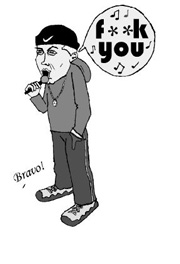This week, I had been planning to write a column on the creeping increase in corporate presence in public schools—both locally and nationally. It’s an important topic, but it’ll have to wait for another time. It’s hard to imagine writing anything on schools and youth right now other than on the horrific April 20 massacre in suburban Denver, and the lessons—or lack of them—that a mortified country can draw from the tragedy.
For a parent or teacher, can there have been anything more terrifying than this event? This was the fourth, and most spectacular schoolyard mass murder in a little more than a year. The towns where the violence has erupted are the picture of ordinariness—Paducah, Jonesboro, Springfield, and now Littleton. Anywhere. The horror is the unpredictability; the next time bomb could go off in your child’s classroom. Or—the ultimate horror—the next seemingly normal kid who decides to act on his psychotic urges could be yours.
How do you know? How do you prevent it? What do you do? These are scary questions, to which I don’t pretend to have answers. I am as frightened and bewildered as anyone by the phenomenon of teens who are so desensitized, or so full of hate, or both, that they are willing to act on urges to mow down a cafeteria.
But I am also afraid of my reaction, and that of other adults. These are, after all, just four instances out of a country of tens of millions of almost entirely non-psychopathic young people. People win the lottery or get struck by lightning far more often than they are victimized by these types of attacks. The temptation to issue sweeping edicts on the state of the nation’s youth is as easy as it is wrong.
Last week’s murders in Colorado gave the nation’s media another chance to titillate, sensationalize, and promote fear at the expense of our nation’s young. It fits especially neatly into the universe of local TV news, with its emphasis on violent crime—often committed by youth, and especially youth of color. Viewers come away with the unconscious or often explicit impression that such violence is on the rise, pandemic, and that we are raising a generation of kids that is somehow fundamentally Not Like Us. Heaven help us if they wear black and listen to Marilyn Manson or Puff Daddy.
The myth of violent youth fuels all sorts of repressive political trends: curfews, harassment of youth dances and gatherings, criminalizing runaways and the homeless, the ever-expanding juvenile gulag, and far too much more.Young people in Washington state essentially have no rights under the law. They grow up seeing politicians dedicating projects “for the kids” while they treat those kids with fear and contempt—and, needless to say, never actually listen to young peoples’ opinions, which are often astonishingly well-informed and insightful.
The real story, in Littleton and in every town, is not the violence inflicted by youth, but the violence inflicted on youth, from TV, Ritalin-style mind-controlling drugs, and high expectations of early childhood, through the soul-deadening experience that is the American schooling system, and on to the pure phobia (equal parts terror, fear, and jealousy) adults manifest toward teens. And that’s for the kids who hail from “good” towns like Littleton. The ones in “bad” neighborhoods, or with inappropriate skin colors, or going hungry, or pregnant, or with unstable or abusive parents or no parents at all, have considerably more to overcome.
It’s easy to imagine calls for (more) metal detectors in schools, for more aggressive psychological screening of students, for tougher juvenile crime sentences, and other such responses to Littleton. The concern is understandable, but the fear and mistrust it demonstrates in our nation’s youth sends exactly the wrong message. Our public schools need to be places for learning, not minimum security prisons. Putting more resources in our kids’ lives—a pay hike for teachers is an obvious issue but far from the only one—would do a lot more to demonstrate that we care.
Nowhere to run
A few weeks ago, I wrote about our dog, Kit. Her newfound celebrity has not particularly changed her desire to beg for Cheez-Its, but it also didn’t do her much good on the issue at hand, which was the possible loss of the off-leash area (OLA) at Magnuson Park, one of the only well-maintained OLAs in the city.
A major conflict is brewing on the issue between Jones & Jones, the firm in charge of the redesign, and the City Council. According to Citizens for Off Leash Areas, the various plans now being floated by Jones & Jones feature a 90 percent reduction in the off-leash area, including closing off the current access to shoreline and putting the main body of the remaining walk at below ground level. And while the Magnuson OLA is by all accounts heavily used, its proposed effective abolition is only one piece of a larger plan seemingly designed to discourage park use of all kinds in favor of the aesthetics of wetland restoration and a Discovery Parkstyle enclave for Sand Point residents to gaze upon. Such plans aren’t going to sit well with the City Council, which has stated it expects any revision of the OLA to include an area comparable to the present size, continued shoreline access, and continued accessibility for the disabled.
The conflict, essentially, is between the way the city does business now and the way it did 20 (or five) years ago. Magnuson’s anti-user bias comes from a self-selected blue-ribbon panel stacked with Old Seattle heavyweights like Charles Royer and Jeannette Williams who simply aren’t accustomed to being contradicted by the council, let alone by community groups who have their own needs. Chances are good council (and dog owners and boaters and picnickers, and ball field and beach users) will eventually prevail on this one, but the question remains: Why is it so difficult to get the city to meet the need for something as simple as a place to play with my dog?






